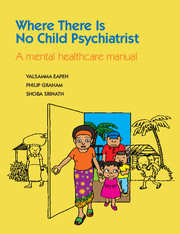Book contents
- Frontmatter
- Contents
- Preface
- Acknowledgements
- Abbreviations
- List of tables and boxes
- 1 Introduction
- 2 Assessment and treatment: general principles
- 3 Making a summary and action plan
- 4 Development and developmental problems
- 5 Intellectual disability
- 6 Habit disorders
- 7 Emotional problems
- 8 Behaviour and related problems
- 9 Specific problems in adolescence
- 10 Alcohol and drug dependency
- 11 Psychotic disorders
- 12 Chronic physical illness and disability
- 13 Physical illness without an identifiable physical explanation
- 14 Stressful situations
- 15 Parents and the needs of children
- 16 Mental health promotion
- 17 Medication
- References and suggested reading
- Appendix 1 My star chart
- Appendix 2 Guide to medication for use in childhood mental disorders
- Index
3 - Making a summary and action plan
Published online by Cambridge University Press: 29 April 2024
- Frontmatter
- Contents
- Preface
- Acknowledgements
- Abbreviations
- List of tables and boxes
- 1 Introduction
- 2 Assessment and treatment: general principles
- 3 Making a summary and action plan
- 4 Development and developmental problems
- 5 Intellectual disability
- 6 Habit disorders
- 7 Emotional problems
- 8 Behaviour and related problems
- 9 Specific problems in adolescence
- 10 Alcohol and drug dependency
- 11 Psychotic disorders
- 12 Chronic physical illness and disability
- 13 Physical illness without an identifiable physical explanation
- 14 Stressful situations
- 15 Parents and the needs of children
- 16 Mental health promotion
- 17 Medication
- References and suggested reading
- Appendix 1 My star chart
- Appendix 2 Guide to medication for use in childhood mental disorders
- Index
Summary
This is a very short chapter but it contains information that will be important for the children and families that you see.
When you have finished your assessment and considered the treatment possibilities that are available, you will need to make a summary and a plan of action. This is sometimes called a formulation. Ideally, this is written down, but often lack of time will mean this is not possible. You should, all the same, make a summary in your mind of all the relevant information you have gathered and of the action you have decided to take.
Making a summary
You first need to decide whether the lives of the child and/or family members are being affected by the problem. Is the child's functioning at home or at school impaired by the problem? If the child is eating and sleeping well, getting on reasonably well with other family members, making progress at school and has friends whom he enjoys seeing, then there probably is no reason for concern. The mother may all the same have anxieties about the child and may well need reassurance, perhaps repeated reassurance, but the child does not need treatment.
If, however, the lives of the child and/or family members are being affected by the child's developmental progress, behaviour or emotional life, then you do need to make a summary and action plan. You need to include in your summary the following.
• The nature and extent of the problem or problems (often more than one of these is present):
• developmental or intellectual
• habit disorders
• emotional disorders
• behaviour problems
• self-harm
• mental health difficulties arising from chronic physical illness or disability
• physical symptoms without physical cause
• severe mental disorders, especially psychoses
• drug use disorders, alcohol and drug dependency.
• The possible causes of the problems or problems:
• genetic
• physical
• stresses arising from the environment (from the world in which the child is currently living), especially within the family or at school:
a traumatic or damaging experiences that have happened to the child in the past
b an interaction between any or all of the aforementioned possible causes. This is easily the most common situation.
- Type
- Chapter
- Information
- Where There Is No Child PsychiatristA Mental Healthcare Manual, pp. 9 - 10Publisher: Royal College of PsychiatristsPrint publication year: 2012
- Creative Commons
- This content is Open Access and distributed under the terms of the Creative Commons Attribution licence CC-BY-NC-ND 4.0 https://creativecommons.org/cclicenses/



